
Boise State University MS Raptor Biology student Jessica Taylor defended their thesis, “Nesting In Urban Areas Affects American Kestrel Home Range Size And Adult Female Health” on the afternoon of March 6, 2024. Taylor’s main advisor is Julie Heath (MS, Raptor Biology, ’96; Boise State University Raptor Research Center; Biological Sciences), and their committee includes Dave Oleyar (Biological Sciences, Co-Chair) and Jen Cruz (Boise State University Raptor Research Center, Biological Sciences).
ABSTRACT
Urbanization is happening at an unprecedented rate, and wildlife must adapt or face population declines. American Kestrels inhabit urban areas, however, whether human-dominated landscapes impact kestrel space use, survival, and reproductive success is largely unknown. We monitored American Kestrel nest boxes along a gradient of urbanization, measured using impervious surface area (ISA), and deployed GPS tags on breeding adults to examine the relationship between urbanization, home range size, and adult and nestling health.
Male kestrel home ranges were 9.14 times larger than female home ranges, and home range size decreased as ISA increased for both sexes (β = -1.96, SE = 0.52). Adult females lost weight at twice the rate over the breeding season than adult males, and, although there was no relationship between weight loss and home range size, females lost more weight as ISA increased (β = 0.16, SE = 0.11). The effect of female home range size on overall nestling mass and the variation of mass within nests depended on ISA (overall: β = -0.36, SE = 0.24, variation: β = 33.69, SE = 13.6). Nestling mass was highest and within-brood mass variation was lowest with large home ranges in less urban areas, but this relationship was reversed in areas with more urbanization, where smaller home ranges lead to higher nestling mass and lower variation than larger home ranges. Male home range size did not predict overall nestling mass but showed a similar, dependent effect on within-nest mass variation as the female home range size (β = 13.00, SE = 4.29). Results suggest that smaller home range sizes in urban areas may be adaptive for kestrels. However, the effects of urbanization on adult female weight loss show that while kestrels can successfully breed in urban areas, it could come at a cost to female health and potentially to survival. Kestrels may not be as well adapted to urbanization as previously reported.